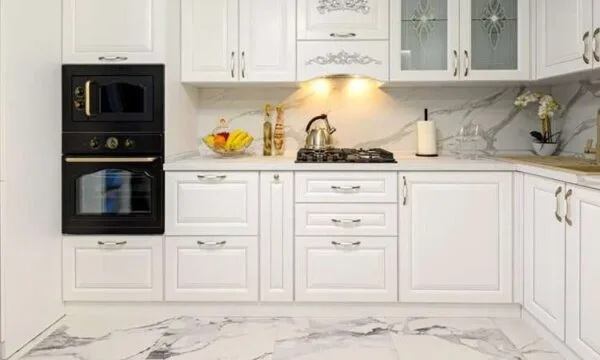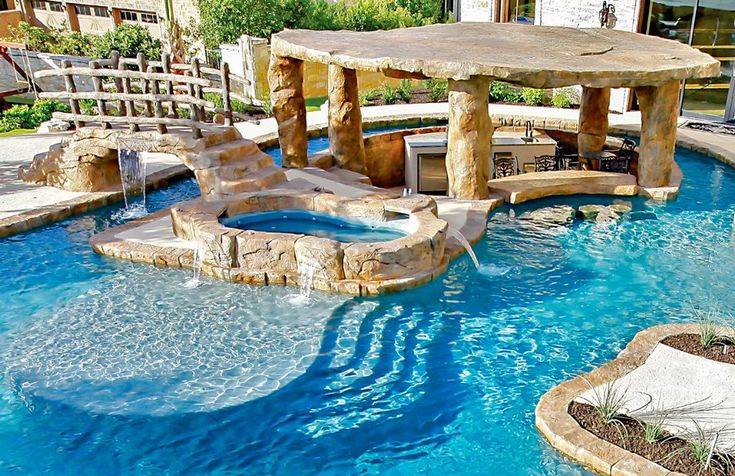The kitchen sink is often called the heart of the kitchen, and for good reason. It’s where we prepare meals, clean dishes, and sometimes even bathe small children or pets. A well-designed sink can make your daily tasks easier and more enjoyable while enhancing your kitchen’s aesthetic.
Whether renovating your kitchen or building a new home in Dubai, understanding kitchen sink design is crucial for creating a functional and beautiful space.
Understanding the Basics of Kitchen Sink design
Beyond the material and style considerations, it’s essential to understand the practical aspects of kitchen sinks. For example, the configuration of the sink, whether it’s a single bowl, double bowl, or farmhouse style, can significantly impact daily usability.
Types of Kitchen Sinks
Before diving into materials and designs, it’s important to understand the different types of kitchen sinks available:
Drop-in Sinks:
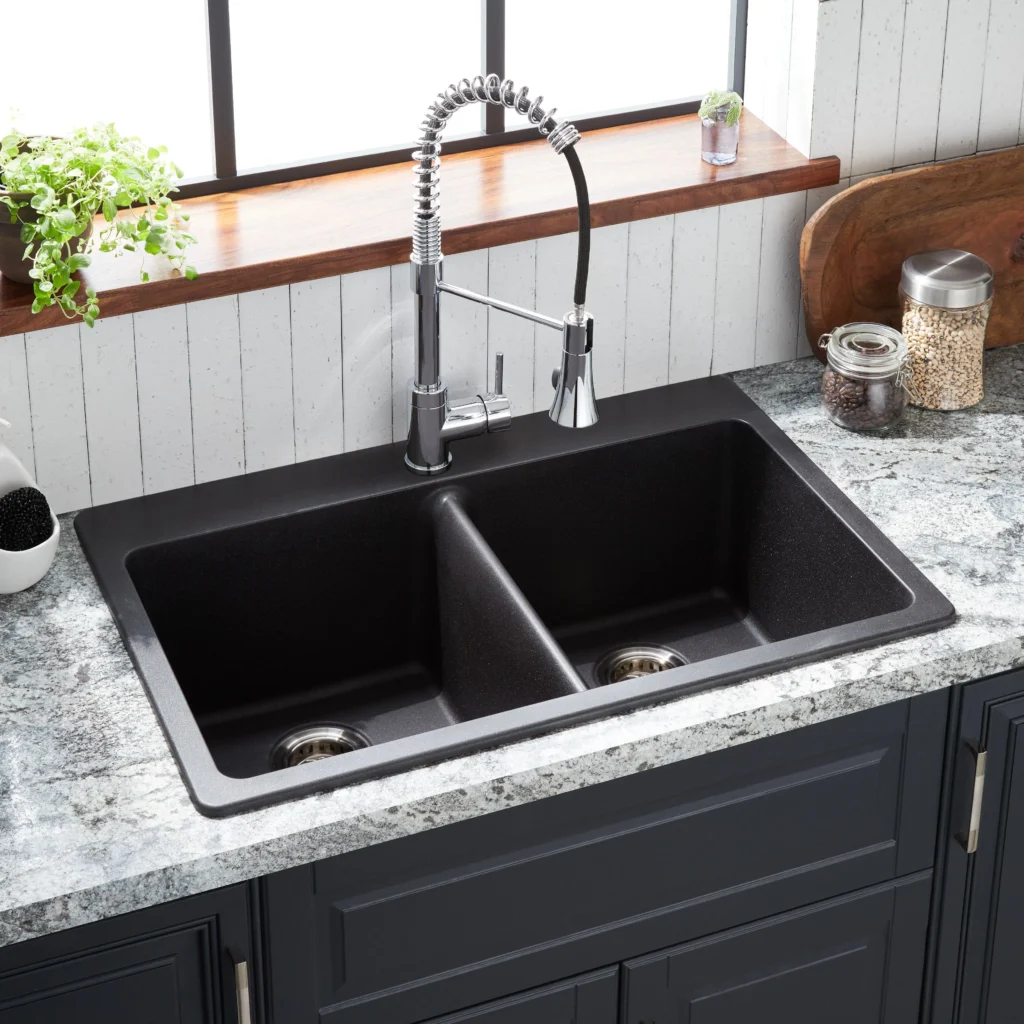
Also known as top-mount sinks, these are the most common and easiest to install. They’re dropped into a pre-cut hole in the countertop and have a visible rim that sits on top of the counter.
Undermount Sinks:
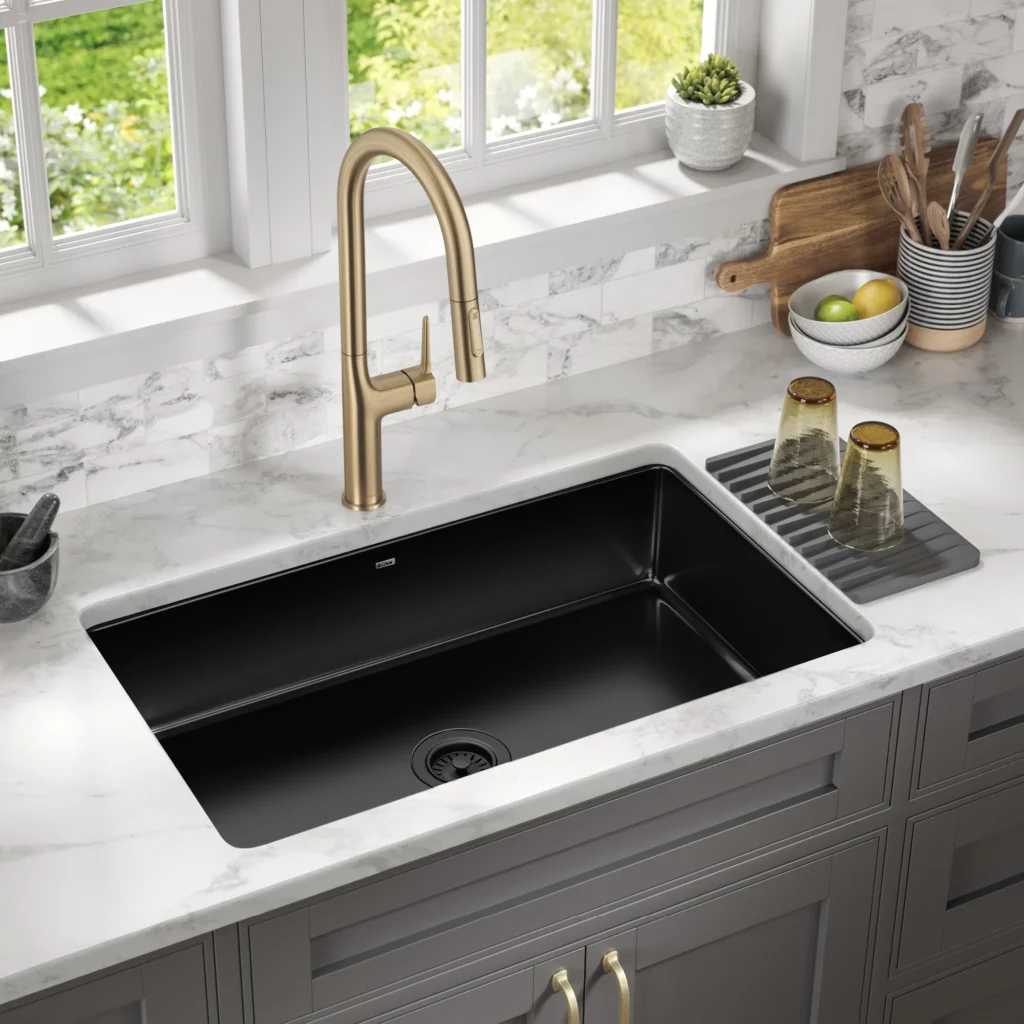
These sinks are installed beneath the countertop, creating a seamless look. They’re popular in modern kitchens and make cleaning the countertop easier as there’s no rim to catch debris.
Farmhouse (Apron-front) Sinks:
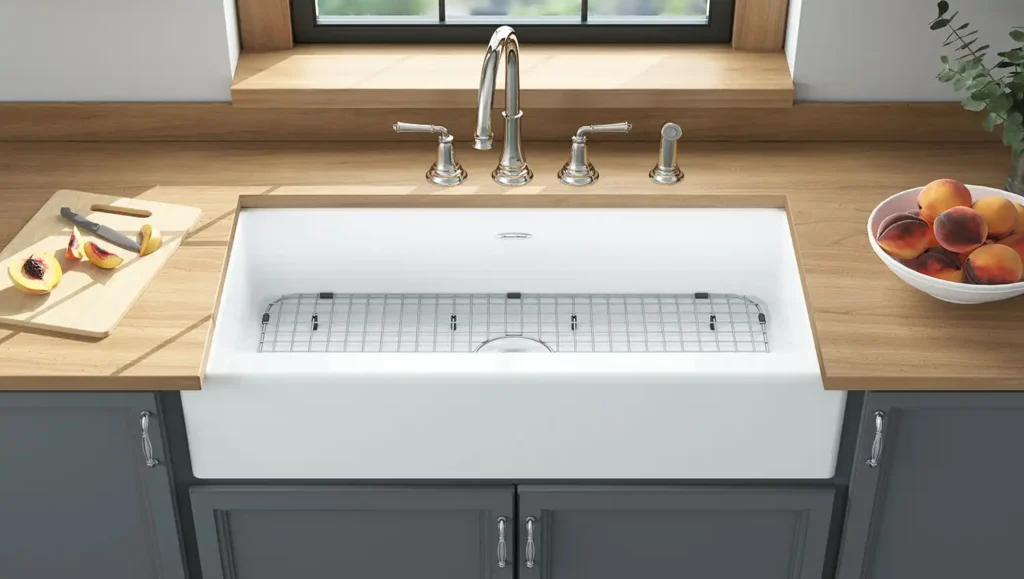
These sinks have a distinctive front panel that’s visible from the outside of the cabinet. They offer a deep basin and are popular in rustic or country-style kitchens.
Integrated Sinks:
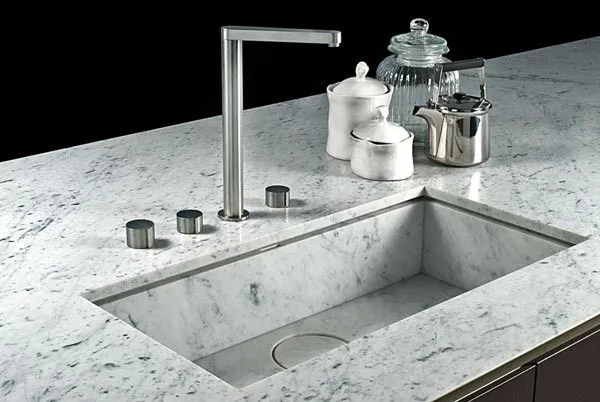
These are made from the same material as the countertop, creating a smooth, continuous surface. They’re often custom-made and can be more expensive.
Corner Sinks:
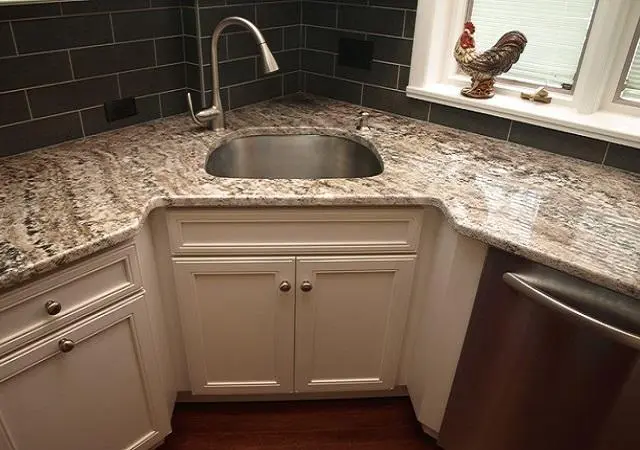
Designed to fit into a corner, these sinks are ideal for small kitchens or oddly-shaped spaces.
Materials for Kitchen Sink designs
The material of your sink affects its durability, maintenance requirements, and overall look. Here are some popular options:
- Stainless Steel: Durable, affordable, and easy to clean, stainless steel sinks are a popular choice. They resist heat and stains but can be noisy and may show water spots.
- Porcelain/Ceramic: These sinks offer a classic look and come in various colors. They’re resistant to stains and scratches but can chip if heavy objects are dropped on them.
- Composite Materials: Made from a mixture of natural stone dust and resins, composite sinks (like granite or quartz) are extremely durable and resist scratches, stains, and heat.
- Cast Iron: These heavy-duty sinks are coated with enamel and are known for their durability and classic look. They can be prone to chipping and are very heavy, which may require extra support.
- Fireclay: Similar to cast iron but more durable, fireclay sinks are resistant to scratches, stains, and chips. They’re popular for farmhouse-style sinks.
- Copper: Offering a unique, warm look, copper sinks are naturally antimicrobial. They develop a patina over time, which some find appealing while others may not.
Design Considerations
When choosing a kitchen sink design, consider the following factors:
- Single Bowl vs. Double Bowl: Single bowl sinks offer more space for large items, while double bowl sinks allow for multitasking (e.g., washing on one side, rinsing on the other).
- Size and Depth: Consider the size of your kitchen and your typical usage. Deeper sinks are great for hiding dirty dishes but may be uncomfortable for shorter individuals.
- Shape: While rectangular sinks are most common, you can also find oval, round, or custom shapes to suit your kitchen’s style.
- Drain Placement: Center drains are standard, but off-center drains can provide more usable space in the bottom of the sink.
- Faucet Holes: Ensure your sink has the correct number of holes for your chosen faucet and any accessories (like soap dispensers or filtered water taps).
Functionality and Features
Modern kitchen sinks offer various features to enhance functionality:
- Built-in Drainboards: These sloped areas next to the sink basin help with draining and drying dishes.
- Workstation Sinks: These sinks come with integrated cutting boards, colanders, and drying racks that slide across the top of the sink.
- Accessories: Many sinks offer compatible accessories like cutting boards, dish racks, and colanders that fit within the sink.
- Sound-Dampening Technology: Some sinks, especially stainless steel ones, come with undercoatings or pads to reduce noise.
Matching Sinks with Kitchen Styles
Your sink should complement your overall kitchen style:
- Modern and Contemporary: Sleek under-mount stainless steel or composite sinks work well in modern kitchens.
- Traditional and Classic: Farmhouse sinks or porcelain drop-in sinks often suit traditional styles.
- Rustic and Farmhouse: Apron-front sinks in fireclay or copper are popular choices for rustic kitchens.
- Industrial: Large, deep stainless steel sinks complement an industrial aesthetic.
Coordinating Sinks with Countertops and Tiles
Harmony between your sink, countertop, and tiles is crucial for a cohesive look:
- Color Coordination: Choose a sink color that either matches or contrasts nicely with your countertop and backsplash.
- Material Compatibility: Ensure the sink material works well with your countertop. For example, a heavy cast iron sink might require extra support in some countertops.
- Grout Considerations: If using tiles around your sink, choose a grout color and width that complements both the tiles and the sink.
Kitchen Sink Installation Methods
The installation method can affect both the look and functionality of your sink:
- Top-mount Installation: Easier to install and works with any countertop material, but the rim can collect dirt and make cleaning more difficult.
- Undermount Installation: This creates a seamless look and makes cleaning easier, but installation is more complex and may not be suitable for all countertop materials.
- Professional vs. DIY Installation: While some handy homeowners might tackle a drop-in sink installation, under-mount and farmhouse sinks often require professional installation.
Maintenance and Care
Proper maintenance ensures your sink’s longevity:
Kitchen sink Cleaning Techniques:
- Stainless steel: Use mild soap and water, avoiding abrasive cleaners.
- Porcelain/ceramic: Regular cleaning with non-abrasive cleaners; avoid sudden temperature changes.
- Composite: Wipe with soap and water; avoid harsh chemicals.
- Cast iron/enamel: Clean with mild detergent; avoid abrasive materials.
- Copper: Use mild soap and water; avoid acidic cleaners that can damage the patina.
Preventing Scratches and Stains:
- Use sink grids or mats to protect the bottom of the sink.
- Avoid leaving acidic foods or harsh chemicals in the sink for extended periods.
- Rinse and dry the sink after each use to prevent water spots and mineral buildup.
Long-term Care Tips:
- Address any chips or cracks promptly to prevent further damage.
- Re-seal granite or stone sinks annually.
- Polish stainless steel sinks occasionally to maintain shine.
Cost Factors
Budget considerations for kitchen sinks:
Price Ranges:
- Stainless steel: $100 – $1,000+
- Porcelain/ceramic: $200 – $2,000+
- Composite: $200 – $1,500+
- Cast iron: $300 – $2,000+
- Fireclay: $500 – $3,000+
- Copper: $500 – $4,000+
Additional Costs:
- Installation fees (especially for under-mount or farmhouse sinks)
- Accessories (sink grids, cutting boards, etc.)
- Potential countertop modifications
Long-term Value:
- Consider durability and timelessness of design when assessing cost.
- Higher upfront costs for quality materials may save money in the long run.
Popular Brands and Manufacturers
In Dubai, you can find a wide range of kitchen sink brands:
- Kohler: Known for innovative designs and durability.
- Franke: Offers a variety of materials and styles.
- Blanco: Popular for their granite composite sinks.
- Elkay: Well-regarded for stainless steel sinks.
- Roca: Provides stylish and functional options.
- Grohe: Offers high-end sinks with matching faucets.
Choosing the Right Sink for Your Needs
Consider these factors when making your decision:
Assess Your Kitchen Usage:
- How often do you cook?
- Do you entertain frequently?
- Do you have large pots and pans to wash?
Consider Household Size:
- Larger families might benefit from bigger or double sinks.
- Singles or couples might prefer smaller, more streamlined options.
Balance Aesthetics and Functionality:
- Choose a sink that looks great but also meets your practical needs.
- Consider how the sink will age and whether its style will stand the test of time.
Trends in Kitchen Sink Design
Stay up-to-date with the latest trends:
- Workstation Sinks: These multi-functional sinks with built-in cutting boards, drying racks, and colanders are gaining popularity.
- Matte Finishes: Brushed or matte finishes on stainless steel and other materials are trending, offering a modern look that hides water spots and fingerprints.
- Smart Sinks: Some high-end models now come with touchless faucets, water usage tracking, and even voice-activated controls.
- Bold Colors: While neutral tones remain popular, some homeowners are opting for sinks in bold colors to make a statement.
- Low-Divide Sinks: These offer the advantages of both single and double bowl sinks, with a lower center divider for easier handling of large items.
Environmental Considerations
For the eco-conscious consumer:
- Water-Saving Features: Low-flow faucets can be paired with any sink to reduce water usage. Some sinks come with built-in water filtration systems, reducing the need for bottled water.
- Eco-Friendly Materials: Recycled stainless steel sinks are available from some manufacturers. Sinks made from renewable or sustainable materials like bamboo composites are emerging in the market.
- Durability: Choosing a long-lasting sink reduces the need for replacements, minimizing waste.
Choosing the right kitchen sink is a balance of functionality, aesthetics, and budget. Consider your daily needs, kitchen style, and long-term plans when making your decision. Remember that a quality sink can last for decades, making it a worthy investment in your home. Whether you opt for a classic stainless steel model, a striking copper farmhouse sink, or a cutting-edge smart sink, the perfect option is out there for
your Dubai kitchen. Take your time, do your research, and don’t hesitate to consult with professionals to ensure you make the best choice for your home.
FAQs about Kitchen Sink Design
Q: Are under-mount sinks better than drop-in sinks?
A: It depends on your needs. Undermount sinks offer a sleek look and easier counter cleaning, but they’re more expensive to install and not suitable for all countertop materials.
Q: How do I clean a stainless steel sink without scratching it?
A: Use a soft cloth or sponge with mild dish soap and warm water. Avoid abrasive cleaners or steel wool, which can scratch the surface.



